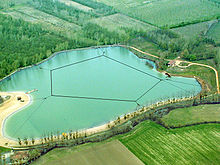
Cable skiing
Encyclopedia

Motorboat
A motorboat is a boat which is powered by an engine. Some motorboats are fitted with inboard engines, others have an outboard motor installed on the rear, containing the internal combustion engine, the gearbox and the propeller in one portable unit.An inboard/outboard contains a hybrid of a...
. The mechanism consists of two cables running parallel to one another with carriers between them every 80 metres. The carriers are metal tubes that can hook up tow ropes with riders. Tow ropes are detached and attached at the same time without slowing the system down, which is a main reason for the high efficiency. With a main cable 800 metres long, 10 riders can waterski or wakeboard at the same time. The speed of the main cable can be up to 38 mph (61 km/h), and slalom skiers can reach much higher speeds. The most common speed is 19 mph (31 km/h), which suits wakeboarders best.
The cable is generally suspended 26–30 feet (8–9 metres) above the water. This makes for a different feel than when riding behind a boat, whether wakeboarding or water skiing.
The higher angle of pull makes bigger air and sharper turns possible. Generally, on wakeboard-only cables, there are ramps and sliders for the riders to use. Another way for wakeboarders to get air on the cable is to "load the line." Loading the line is putting tension on the rope and using the water as a spring to fling oneself into the air. Though it is possible to do this behind a boat, the higher angle of pull and the slight jerk on the corners allow good riders to get much higher.
Other important advantages of the cable compared to the boat are environmental friendliness and the enormous capacity. The electric motor of the cable is quiet, clean and energy-efficient. A cableway with a main cable 800 metres long operated at 19 mph (31 km/h) makes 38.8 rounds in one hour and the users get 19 miles (31 km) of water skiing or wake boarding in that hour.
Cable skiing was invented by the German engineer Bruno Rixen, who built the first water ski cableway on a lake near Bordesholm, Germany, in 1959; Germany has around 60 cables today.
Cable skiing is popular in Europe and slowly gaining momentum in the United States. In Germany alone there are over 65 active cables. One spot in Germany, Langenfeld, has four cableway systems and the highest water skiing and wakeboarding capacity in the world. There are four cables in Poland - Szczecinek
Szczecinek
Szczecinek [] is a city in Middle Pomerania, northwestern Poland with some 39,777 inhabitants . Previously in Koszalin Voivodeship , it has been the capital of Szczecinek County in the West Pomeranian Voivodeship since 1999...
(1100 m), Ostróda
Ostróda
Ostróda is a town in Ostróda County in the Warmian-Masurian Voivodeship in Poland, with 33,603 inhabitants as of January 1, 2005. It lies in the Masurian Lake District and is a growing tourist site owing to its relaxing natural surroundings.-History:...
(800 m), Lublin
Lublin
Lublin is the ninth largest city in Poland. It is the capital of Lublin Voivodeship with a population of 350,392 . Lublin is also the largest Polish city east of the Vistula river...
(760 m) and Augustów
Augustów
Augustów is a town in north-eastern Poland with 29,600 inhabitants . It lies on the Netta River and the Augustów Canal. It is situated in the Podlaskie Voivodeship , having previously been in Suwałki Voivodeship . It is the seat of Augustów County and of Gmina Augustów.In 1970 Augustów became...
(740 m). In the U.S. there are 11 cableways.

